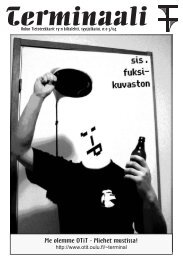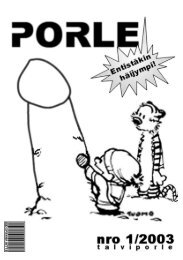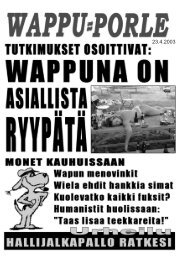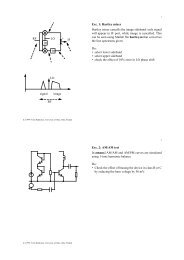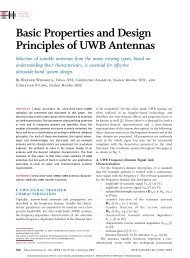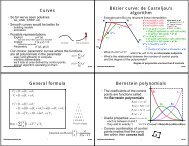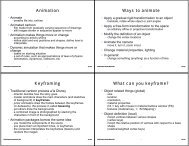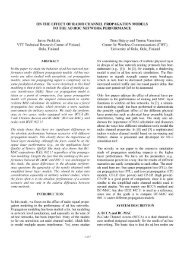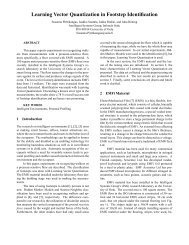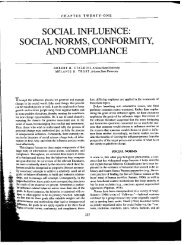Accurate, Dense, and Robust Multiview Stereopsis - Department of ...
Accurate, Dense, and Robust Multiview Stereopsis - Department of ...
Accurate, Dense, and Robust Multiview Stereopsis - Department of ...
Create successful ePaper yourself
Turn your PDF publications into a flip-book with our unique Google optimized e-Paper software.
FURUKAWA AND PONCE: ACCURATE, DENSE, AND ROBUST MULTIVIEW STEREOPSIS 1375<br />
Fig. 18. If segmentation information is not available or users choose not to extract such information from images, a visual hull model cannot be<br />
reconstructed, <strong>and</strong> hence, our iterative snapping algorithm, described in Section 4.1.2, is not applicable. However, PSR s<strong>of</strong>tware [29] can still be<br />
used to produce similar results with only a few noticeable differences (illustrated with red circles), while saving a lot <strong>of</strong> computation time. Compare<br />
them to Fig. 16.<br />
consistency computation, while most other approaches just<br />
assume fronto-parallel surfaces. Quantitative evaluations<br />
provided in [1] show that the proposed approach outperforms<br />
all <strong>of</strong> the other evaluated techniques both in terms <strong>of</strong><br />
accuracy <strong>and</strong> completeness for four out <strong>of</strong> the six data sets. The<br />
implementation <strong>of</strong> the patch-based MVS algorithm (PMVS) is<br />
publicly available in [25]. Our future work will be aimed at<br />
better underst<strong>and</strong>ing the source <strong>of</strong> reconstruction errors <strong>and</strong><br />
obtain even higher accuracy. For example, one interesting<br />
observation from Table 2 is that our results for the largest full<br />
data sets are worse than those for the intermediate ring data<br />
sets, which is in fact the case for some other algorithms.<br />
Further investigation <strong>of</strong> this behavior is part <strong>of</strong> our future<br />
work, together with the analysis <strong>of</strong> how parameter values<br />
influence results. It would also be interesting to study<br />
contributions <strong>of</strong> our mesh refinement step more quantitatively,<br />
which has mostly shown qualitative improvements in<br />
our results. Another possible extension is to model lighting<br />
<strong>and</strong> surface reflectance properties since MVS algorithms like<br />
ours typically assume that an object or a scene is Lambertian<br />
under constant illumination, which is <strong>of</strong> course not true in<br />
practice. Improving the mesh initialization algorithm by<br />
using a technique similar to [39] is also part <strong>of</strong> our future<br />
work.<br />
ACKNOWLEDGMENTS<br />
This work was supported in part by the US National Science<br />
Foundation under grant IIS-0535152, the INRIA associated<br />
team Thetys, <strong>and</strong> the Agence Nationale de la Recherche<br />
under grants Hfibmr <strong>and</strong> Triangles. The authors thank<br />
S. Seitz, B. Curless, J. Diebel, D. Scharstein, <strong>and</strong> R. Szeliski<br />
for the temple <strong>and</strong> dino data sets <strong>and</strong> evaluations, S. Sullivan,<br />
A. Suter, <strong>and</strong> Industrial Light <strong>and</strong> Magic for face, face-2, body,<br />
steps-1, <strong>and</strong> wall, C. Strecha for city-hall <strong>and</strong> brussels, <strong>and</strong><br />
finally J. Blumenfeld <strong>and</strong> S.R. Leigh for the skull data set.<br />
REFERENCES<br />
[1] S.M. Seitz, B. Curless, J. Diebel, D. Scharstein, <strong>and</strong> R. Szeliski,<br />
“Multi-View Stereo Evaluation,” http://vision.middlebury.edu/<br />
mview/, 2010.<br />
[2] S.M. Seitz, B. Curless, J. Diebel, D. Scharstein, <strong>and</strong> R. Szeliski, “A<br />
Comparison <strong>and</strong> Evaluation <strong>of</strong> Multi-View Stereo Reconstruction<br />
Algorithms,” Proc. IEEE Conf. Computer Vision <strong>and</strong> Pattern<br />
Recognition, 2006.<br />
[3] O. Faugeras <strong>and</strong> R. Keriven, “Variational Principles, Surface<br />
Evolution, PDE’s, Level Set Methods <strong>and</strong> the Stereo Problem,”<br />
IEEE Trans. Image Processing, vol. 7, no. 3, pp. 336-344, Mar. 1998.<br />
[4] S. Paris, F. Sillion, <strong>and</strong> L. Quan, “A Surface Reconstruction<br />
Method Using Global Graph Cut Optimization,” Proc. Asian Conf.<br />
Computer Vision, http://artis.imag.fr/Publications/2004/PSQ04,<br />
Jan. 2004.<br />
[5] J.-P. Pons, R. Keriven, <strong>and</strong> O.D. Faugeras, “Multi-View Stereo<br />
Reconstruction <strong>and</strong> Scene Flow Estimation with a Global Image-<br />
Based Matching Score,” Int’l J. Computer Vision, vol. 72, no. 2,<br />
pp. 179-193, 2007.<br />
[6] S. Tran <strong>and</strong> L. Davis, “3D Surface Reconstruction Using Graph<br />
Cuts with Surface Constraints,” Proc. European Conf. Computer<br />
Vision, 2006.<br />
[7] G. Vogiatzis, P.H. Torr, <strong>and</strong> R. Cipolla, “Multi-View Stereo Via<br />
Volumetric Graph-Cuts,” Proc. IEEE Conf. Computer Vision <strong>and</strong><br />
Pattern Recognition, 2005.<br />
[8] A. Hornung <strong>and</strong> L. Kobbelt, “Hierarchical Volumetric Multi-View<br />
Stereo Reconstruction <strong>of</strong> Manifold Surfaces Based on Dual Graph<br />
Embedding,” Proc. IEEE Conf. Computer Vision <strong>and</strong> Pattern<br />
Recognition, 2006.<br />
[9] S. Sinha, P. Mordohai, <strong>and</strong> M. Pollefeys, “Multi-View Stereo via<br />
Graph Cuts on the Dual <strong>of</strong> an Adaptive Tetrahedral Mesh,” Proc.<br />
Int’l Conf. Computer Vision, 2007.<br />
[10] C. Hernández Esteban <strong>and</strong> F. Schmitt, “Silhouette <strong>and</strong> Stereo<br />
Fusion for 3D Object Modeling,” Computer Vision <strong>and</strong> Image<br />
Underst<strong>and</strong>ing, vol. 96, no. 3, pp. 367-392, 2004.<br />
[11] A. Zaharescu, E. Boyer, <strong>and</strong> R. Horaud, “Transformesh: A<br />
Topology-Adaptive Mesh-Based Approach to Surface Evolution,”<br />
Proc. Asian Conf. Computer Vision, Y. Yagi, S.B. Kang, I.-S. Kweon,<br />
<strong>and</strong> H. Zha, eds., pp. 166-175, 2007.<br />
[12] Y. Furukawa <strong>and</strong> J. Ponce, “Carved Visual Hulls for Image-Based<br />
Modeling,” Int’l J. Computer Vision, vol. 81, pp. 53-67, Mar. 2009.<br />
[13] B. Baumgart, “Geometric Modeling for Computer Vision,” PhD<br />
dissertation, Stanford Univ., 1974.<br />
[14] M. Goesele, B. Curless, <strong>and</strong> S.M. Seitz, “Multi-View Stereo<br />
Revisited,” Proc. IEEE Conf. Computer Vision <strong>and</strong> Pattern Recognition,<br />
pp. 2402-2409, 2006.<br />
[15] C. Strecha, R. Fransens, <strong>and</strong> L.V. Gool, “Combined Depth <strong>and</strong><br />
Outlier Estimation in Multi-View Stereo,” Proc. IEEE Conf.<br />
Computer Vision <strong>and</strong> Pattern Recognition, pp. 2394-2401, 2006.<br />
[16] D. Bradley, T. Boubekeur, <strong>and</strong> W. Heidrich, “<strong>Accurate</strong> Multi-View<br />
Reconstruction Using <strong>Robust</strong> Binocular Stereo <strong>and</strong> Surface<br />
Meshing,” Proc. IEEE Conf. Computer Vision <strong>and</strong> Pattern Recognition,<br />
2008.<br />
[17] M. Lhuillier <strong>and</strong> L. Quan, “A Quasi-<strong>Dense</strong> Approach to Surface<br />
Reconstruction from Uncalibrated Images,” IEEE Trans. Pattern<br />
Analysis <strong>and</strong> Machine Intelligence, vol. 27, no. 3, pp. 418-433, Mar.<br />
2005.<br />
[18] M. Habbecke <strong>and</strong> L. Kobbelt, “Iterative Multi-View Plane<br />
Fitting,” Proc. 11th Fall Workshop Vision, Modeling, <strong>and</strong> Visualization,<br />
2006.




